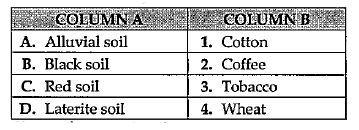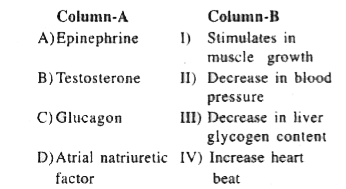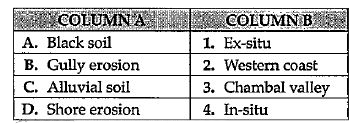Choose the correct options.
Viscosity of liquids increases with temperature
Viscosity of gases increases with temperature
surface tension of liquids decreases with temperature
For angle of contact(θ)=(0∘), liquid neither rises nor falls on capillary
The correct Answer is:B, C
To solve the question, we need to evaluate each of the four statements regarding viscosity, surface tension, and angle of contact, and determine which ones are correct.
1. Evaluate the first statement: "Viscosity of liquid increases with temperature."
- Viscosity is a measure of a fluid's resistance to flow. For liquids, as the temperature increases, the kinetic energy of the molecules increases, which reduces the intermolecular forces. This leads to a decrease in viscosity.
- Conclusion: This statement is incorrect.
2. Evaluate the second statement: "Viscosity of gases increases with temperature."
- For gases, as the temperature increases, the kinetic energy of the molecules also increases. This results in more frequent and energetic collisions between the gas molecules, which increases the viscosity.
- Conclusion: This statement is correct.
3. Evaluate the third statement: "Surface tension of liquid decreases with temperature."
- Surface tension is caused by cohesive forces between liquid molecules. As temperature increases, these cohesive forces decrease due to increased molecular motion, leading to a decrease in surface tension.
- Conclusion: This statement is correct.
4. Evaluate the fourth statement: "For angle of contact θ = 0°, liquid neither rises nor falls in a capillary."
- The angle of contact (or wetting angle) determines the behavior of a liquid in a capillary. If θ = 0°, the liquid completely wets the surface, and it will rise in the capillary. The condition for a liquid to neither rise nor fall is when θ = 90°.
- Conclusion: This statement is incorrect.
Final Evaluation of Statements:
- Statement 1: Incorrect
- Statement 2: Correct
- Statement 3: Correct
- Statement 4: Incorrect
Summary of Correct Options:
The correct options are:
- Viscosity of gases increases with temperature.
- Surface tension of liquid decreases with temperature.
- Viscosity is a measure of a fluid's resistance to flow. For liquids, as the temperature increases, the kinetic energy of the molecules increases, which reduces the intermolecular forces. This leads to a decrease in viscosity.
- Conclusion: This statement is incorrect.
- For gases, as the temperature increases, the kinetic energy of the molecules also increases. This results in more frequent and energetic collisions between the gas molecules, which increases the viscosity.
- Conclusion: This statement is correct.
- Surface tension is caused by cohesive forces between liquid molecules. As temperature increases, these cohesive forces decrease due to increased molecular motion, leading to a decrease in surface tension.
- Conclusion: This statement is correct.
- The angle of contact (or wetting angle) determines the behavior of a liquid in a capillary. If θ = 0°, the liquid completely wets the surface, and it will rise in the capillary. The condition for a liquid to neither rise nor fall is when θ = 90°.
- Conclusion: This statement is incorrect.
- Statement 1: Incorrect
- Statement 2: Correct
- Statement 3: Correct
- Statement 4: Incorrect
The correct options are:
- Viscosity of gases increases with temperature.
- Surface tension of liquid decreases with temperature.
Topper's Solved these Questions
- FLUID MECHANICSBOOK - DC PANDEY ENGLISHCHAPTER - FLUID MECHANICSEXERCISE - Level 2 Comprehension Based
7 Videos
- FLUID MECHANICSBOOK - DC PANDEY ENGLISHCHAPTER - FLUID MECHANICSEXERCISE - Subjective
24 Videos
- FLUID MECHANICSBOOK - DC PANDEY ENGLISHCHAPTER - FLUID MECHANICSEXERCISE - Level 2 Single Correct
36 Videos
- EXPERIMENTSBOOK - DC PANDEY ENGLISHCHAPTER - EXPERIMENTSEXERCISE - Subjective
15 Videos
- GENERAL PHYSICSBOOK - DC PANDEY ENGLISHCHAPTER - GENERAL PHYSICSEXERCISE - INTEGER_TYPE
2 Videos
Similar Questions
Knowledge Check
Choose the correct option as directed.
ACsH>KH>NaH>LiH (Order of stability)BH2O<NH3<CH4 (Order of dipole moment)CPH3<AsH3<NH3<SbH3 (Order of boiling point)DX−−−H−X,X=O>F>N>S>Cl (Order of strength of H-bonding)Choose the correct option to match the following :
 A(A)-(iv),(B)-(i),(C )-(iii),(D)-(ii)B(A)-(ii), (B)-(i),(C )-(iv),(D)-(iii)C(A)-(iii),(B)-(i),(C )-(iv),(D)-(ii)D(A)-(iii),(B)-(i),(C )-(iv),(D)-(ii)
A(A)-(iv),(B)-(i),(C )-(iii),(D)-(ii)B(A)-(ii), (B)-(i),(C )-(iv),(D)-(iii)C(A)-(iii),(B)-(i),(C )-(iv),(D)-(ii)D(A)-(iii),(B)-(i),(C )-(iv),(D)-(ii)Match the following

Choose the correct option:AA-3, B-2, C-1, D-4BA-4, B-1, C-3, D-2CA-2, B-4, C-1, D-3DA-4, B-1, C-2, D-3

_CHE_E06_278.png) Choose the correct option.
Choose the correct option.

